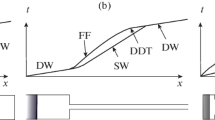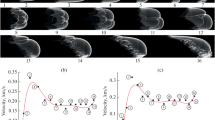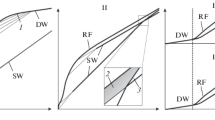In the work, the authors have presented a systematization of the data on acceleration of the flame in a smooth channel filled with gaseous fuel mixture. A mixture of acetylene and oxygen, for which novel experimental and calculation- theoretical investigations have been carried out, was selected as an example of the fuel mixture. On the basis of comprehensive analysis, the authors have described in detail all stages of development of the process, including the initial stage of exponential acceleration of the flame, the stage of restructuring of the flame front accompanied by its retardation, the resumption of flame acceleration, and the creation of conditions for detonation transition. It has been demonstrated that of paramount importance in the development of each stage are hydrodynamic processes determining, in particular, the behavior of the flame in the flow formed in the channel and its acceleration and the compression of the fuel mixture, which is coordinated with it. This leads to the creation of conditions for the formation of detonation. Importantly, the carried-out calculations reproduce, at a qualitative level, all stages of development of the flame, and a parametric analysis of conditions for the transition to detonation quantitatively predicts, with a good degree of accuracy, the critical detonation-transition conditions determined experimentally.
Similar content being viewed by others
References
J. Abe, A. Popoola, E. Ajenifuja, and O. Popoola, Hydrogen energy, economy and storage: Review and recommendation, Int. J. Hydrogen Energy, 44, Issue 29, 15072–15086 (2019).
Z. Liu, Y. Li, G. Yang, and W. Wang, Development path of China's gas power industry under the background of lowcarbon transformation, Natural Gas Industry B, 8, Issue 6, 576–587 (2021).
M. S. Assad and O. G. Penyazkov, Distinctive features of operation of an internal combustion engine running on hydrogen-containing fuels, J. Eng. Phys. Thermophys., 83, No. 4, 869–875 (2010).
V. S. Ivanov, S. M. Frolov, A. E. Zangiev, V. I. Zvegintsev, and I. O. Shamshin, Updated conceptual design of hydrogen/ethylene fueled detonation ramjet: Test fires at Mach 1.5, 2.0, and 2.5, Aerospace Sci. Technol., 126, Article ID 107602 (2022).
M. S. Assad, V. V. Leshchevich, V. N. Mironov, O. G. Penyazkov, K. L. Sevruk, and A. V. Skilond′, Burning of hydrogeneous mixtures in the model of an internal-combustion-engine chamber, J. Eng. Phys. Thermophys., 82, No. 6, 1042–1058 (2009).
A. Yu. Krainov and K. M. Moiseeva, Modeling of the combustion of a methane–air mixture in an enclosed spherical volume, J. Eng. Phys. Thermophys., 91, No. 4, 918–924 (2018).
A. E. Smygalina, A. D. Kiverin, V. M. Zaichenko, and A. I. Tsyplakov, On the efficiency of utilization of hydrogen and syngas in a spark-ignition engine, J. Eng. Phys. Thermophys., 95, No. 1, 168–176 (2022).
N. N. Smirnov and V. F. Nikitin, Modeling and simulation of hydrogen combustion in engines, Int. J. Hydrogen Energy, 39, Issue 2, 1122–1136 (2014).
N. Smirnov, V. Betelin, V. Nikitin, Y. Phylippov, and J. Koo, Detonation engine fed by acetylene–oxygen mixture, Acta Astronaut., 104, Issue 1, 134–146 (2014).
N. N. Smirnov, V. F. Nikitin, L. I. Stamov, E. V. Mikhalchenko, and V. V. Tyurenkova, Three-dimensional modeling of rotating detonation in a ramjet engine, Acta Astronaut., 163 (A), 168–176 (2019).
A. A. Shtertser, V. Yu. Ul′yanitskii, I. S. Batraev, D. K. Rybin, D. V. Dudina, and Ya. L. Luk′yanov, Metal coatings reinforced by nanosize detonation carbon, in: Powder Metallurgy: Surface Engineering, Novel Composite Materials. Welding [in Russian], Izd. Dom "Belorusskaya Nauka," Minsk (2021), pp. 307–312.
I. S. Yakovenko and A. D. Kiverin, Micro-particles spraying via non-stationary flame acceleration process, Acta Astronaut., 181, 620–632 (2021).
H. D. Ng and J. Lee, Comments on explosion problems for hydrogen safety, J. Loss Prev. Process Ind., 21, Issue 2, 136–146 (2008).
D. Ran, J. Cheng, R. Zhang, Y. Wang, and Y. Wu, Damages of underground facilities in coal mines due to gas explosion shock waves: an overview, Shock Vibr., 2021, 1–11 (2021).
Mitigation of hydrogen hazards in severe accidents in nuclear power plants, Tech. Rep. No. IAEA-TECDOC-1661, International Atomic Energy Agency, Vienna (2011).
A. G. Venetsanos, T. Huld, P. Adams, and J. G. Bartzis, Source, dispersion and combustion modelling of an accidental release of hydrogen in an urban environment, J. Hazard. Mater., 105, Issues 1–3, 1–25 (2003).
V. P. Efremov, M. F. Ivanov, A. D. Kiverin, and A. V. Utkin, Shock-wave dynamics during oil-filled transformer explosions, Shock Waves, 27, Issue 3, 517–522 (2017).
M. Saif, W. Wang, A. Pekalski, M. Levin, and M. I. Radulescu, Chapman–Jouguet deflagrations and their transition to detonation, Proc. Combust. Inst., 36, Issue 2, 2771–2779 (2017).
A. Kiverin, I. Yakovenko, and M. Ivanov, On the structure and stability of supersonic hydrogen flames in channels, Int. J. Hydrogen Energy, 41, Issue 47, 22465–22478 (2016).
P. A. Urtiew and A. K. Oppenheim, Experimental observations of the transition to detonation in an explosive gas, Proc. Res. Soc. A, 295, Issue 1440, 13–28 (1966).
G. D. Salamandra, T. V. Bazhenova, and I. M. Naboko, Formation of detonation wave during combustion of gas in combustion tube, Proc. Combust. Inst., 7, Issue 1, 851–855 (1958).
M. Kuznetsov, V. Alekseev, I. Matsukov, and S. Dorofeev, DDT in a smooth tube filled with a hydrogen–oxygen mixture, Shock Waves, 14, Issue 3, 205–215 (2005).
P. Krivosheyev, O. Penyazkov, and A. Sakalou, Analysis of the final stage of flame acceleration and the onset of detonation in a cylindrical tube using high-speed stereoscopic imaging, Combust. Flame, 216, 146–160 (2020).
N. N. Smirnov and M. V. Tyurnikov, Experimental investigation of deflagration to detonation transition in hydrocarbon–air gaseous mixtures, Combust. Flame, 100, Issue 4, 661–668 (1995).
N. N. Smirnov, V. F. Nikitin, and Yu. G. Phylippov, Deflagration-to-detonation transition in gases in tubes with cavities, J. Eng. Phys. Thermophys., 83, No. 6, 1287–1316 (2010).
S. Taki and T. Fujiwara, One-dimensional nonsteady processes accompanied by the establishment of self-sustained detonation, Symp. (Int.) Combust., 13, Issue 1, 1119–1129 (1971).
E. Dzieminska and A. K. Hayashi, Auto-ignition and DDT driven by shock wave–boundary layer interaction in oxyhydrogen mixture, Int. J. Hydrogen Energy, 38, Issue 10, 4185–4193 (2013).
M. F. Ivanov, A. D. Kiverin, M. A. Liberman, and V. E. Fortov, Mechanism of acceleration of the flame and detonation transition of a hydrogen–oxygen mixture in the channel, Dokl. Ross. Akad. Nauk, 434, No. 6, 756–759 (2010).
S. V. Khomik, S. P. Medvedev, and B. E. Gel′fand, Initiation of explosive processes in hydrogen-containing gas mixtures by a multijet flow of detonation products, Fiz. Goreniya Vzryva, 46, No. 1, 54–59 (2010).
L. Kagan and G. Sivashinsky, On the transition from deflagration to detonation in narrow tubes, Flow Turbul. Combust., 84, No. 3, 423–437 (2010).
P. Clavin, Finite-time singularity associated with the deflagration-to-detonation transition on the tip of an elongated flame-front in a tube, Combust. Flame, 245, Article ID 112347 (2022).
A. D. Kiverin, I. S. Yakovenko, Estimation of critical conditions for deflagration-to-detonation transition in obstructed channels filled with gaseous mixtures, Math. Model. Natur. Phenom., 13, Issue 6, Article ID 54 (2018).
A. D. Kiverin and I. S. Yakovenko, Regimes of high-speed hydrogen flame propagation in channels: Classification and criteria of realization, Combust. Sci. Technol., 192, Issue 1, 1–18 (2018).
A. D. Kiverin, A. E. Smygalina, and I. S. Yakovenko, Classification of the scenarios of development of fast combustion and of deflagration-to-detonation transition in channels, Khim. Fiz., 39, No. 8, 9–15 (2020).
C. Clanet and G. Searby, On the "tulip flame" phenomenon, Combust. Flame, 105, Issues 1–2, 225–238 (1996).
L. N. Pyatnitskii, Flame propagation and acoustics, Fiz. Goreniya Vzryva, 55, No. 6, 3–13 (2019).
Ya. B. Zel′dovich, On the theory of the onset of detonation in gases, Zh. Tekh. Fiz., 17, No. 1, 3–26 (1947).
A. D. Kiverin and I. S. Yakovenko, Evolution of wave patterns and temperature field in shock-tube flow, Phys. Rev. Fluids, 3, Issue 5, Article ID 053201 (2018).
Kenneth K. Kuo, Principles of Combustion, 2nd edn., Wiley-Interscience, New Jersey (2005).
M. A. Liberman, A. D. Kiverin, and M. F. Ivanov, Regimes of chemical reaction waves initiated by nonuniform initial conditions for detailed chemical reaction models, Phys. Rev. E, 85, Issue 5, Article ID 056312 (2012).
V. Bykov, A. Kiverin, A. Koksharov, and I. Yakovenko, Analysis of transient combustion with the use of contemporary CFD techniques, Comput. Fluids, 194, Article ID 104310 (2019).
S. Karabasov and V. Goloviznin, Compact accurately boundary-adjusting high-resolution technique for fluid dynamics, J. Comput. Phys., 228, Issue 19, 7426–7451 (2009).
I. S. Yakovenko, A. V. Yarkov, A. V. Tyrnin, et al., Evaluation of the capabilities of modern kinetic mechanisms of acetylene oxidation for simulating nonstationary combustion processes, Vestn. MGTU im. N. É. Baumana, 104, No. 5, 62–85 (2022); doi: https://doi.org/10.18698/1812-3368-2022-5-62-85.
E. Rokni, A. Moghaddas, O. Askari, et al., Measurement of laminar burning speeds and investigation of flame stability of acetylene (C2H2)/air mixtures, J. Energy Resour. Technol., 137, Issue 1, Article ID 012204 (2015).
A. M. Tereza, V. G. Slutskii, and E. S. Severin, Ignition of acetylene–oxygen mixtures behind shock waves, Russ. J. Phys. Chem. B, 3, Issue 1, 99–108 (2009).
A. M. Tereza, G. L. Agafonov, A. S. Betev, and S. P. Medvedev, Reduction of the detailed kinetic mechanism for efficient simulation of ignition delay for mixtures of methane and acetylene with oxygen, Russ. J. Phys. Chem. B, 14, Issue 6, 951–958 (2020).
B. N. Varatharajan and F. A. Williams, Chemical-kinetic descriptions of high-temperature ignition and detonation of acetylene–oxygen–diluent systems, Combust. Flame, 124, Issue 4, 624–645 (2001).
A. D. Kiverin, A. V. Turnin, and I. S. Yakovenko, Scalability of flame propagation in a channel, Russ. J. Phys. Chem. B, 15, Issue 6, 984–988 (2021).
I. Yakovenko, A. Kiverin, P. Krivosheyev, V. Kuzmitski, A. Navitski, O. Penyazkov, A. Tyurnin, and A. Yarkov, Burning rate estimation based on flame evolution in a channel, Acta Astronaut., 204, 768–775 (2023).
M. F. Ivanov, A. D. Kiverin, I. S. Yakovenko, and M. A. Liberman, Hydrogen–oxygen flame acceleration and deflagration-to-detonation transition in three-dimensional rectangular channels with no-slip walls, Int. J. Hydrogen Energy, 38, Issue 36, 16427–16440 (2013).
P. N. Krivosheyev, A. O. Novitski, and O. G. Penyazkov, Evolution of the reaction front shape and structure on flame acceleration and deflagration-to-detonation transition, Russ. J. Phys. Chem. B, 16, Issue 4, 661–669 (2022).
P. Krivosheyev, A. Novitski, and O. Penyazkov, Flame front dynamics, shape and structure on acceleration and deflagration-to-detonation transition, Acta Astronaut., 204, 692–704 (2023).
P. N. Krivosheyev and O. G. Penyazkov, On the initial stage of combustion of acetylene–oxygen mixtures in a tube, Khim. Fiz., 42, No. 3, 30–35 (2023).
M. F. Ivanov, A. D. Kiverin, and M. A. Liberman, Hydrogen–oxygen flame acceleration and transition to detonation in channels with no-slip walls for a detailed chemical reaction model, Phys. Rev. E, 83, Article ID 056313 (2011).
L. D. Landau and E. M. Lifshits, Course of Theoretical Physics, Vol. VI. Hydrodynamics [in Russian], 4th edn., stereotype, Nauka, Moscow (1988).
Y. K. Troshin, The generalized Hugoniot adiabatic curve, Symp. (Int.) Combust., 7, Issue 1, 789–798 (1958).
M. Silvestrini, B. Genova, G. Parisi, and F. Leon Trujillo, Flame acceleration and DDT run-up distance for smooth and obstacles filled tubes, J. Loss Prev. Process Ind., 21, Issue 5, 555–562 (2008).
G. Ciccarelli and S. Dorofeev, Flame acceleration and transition to detonation in ducts, Prog. Energy Combust. Sci., 34, Issue 4, 499–550 (2008).
Y. A. Baranyshyn, P. N. Krivosheyev, O. G. Penyazkov, et al., Flame front dynamics studies at deflagration-todetonation transition in a cylindrical tube at low-energy initiation mode, Shock Waves, 30, Issue 7, 305–313 (2020).
Author information
Authors and Affiliations
Corresponding author
Additional information
Translated from Inzhenerno-Fizicheskii Zhurnal, Vol. 96, No. 7, pp. 1803–1815, November–December, 2023.
Rights and permissions
Springer Nature or its licensor (e.g. a society or other partner) holds exclusive rights to this article under a publishing agreement with the author(s) or other rightsholder(s); author self-archiving of the accepted manuscript version of this article is solely governed by the terms of such publishing agreement and applicable law.
About this article
Cite this article
Kiverin, A.D., Krivosheyev, P.N., Novitskii, A.O. et al. Acceleration of the Flame in a Smooth Channel and Detonation Transition. J Eng Phys Thermophy 96, 1769–1781 (2023). https://doi.org/10.1007/s10891-023-02847-1
Received:
Published:
Issue Date:
DOI: https://doi.org/10.1007/s10891-023-02847-1




